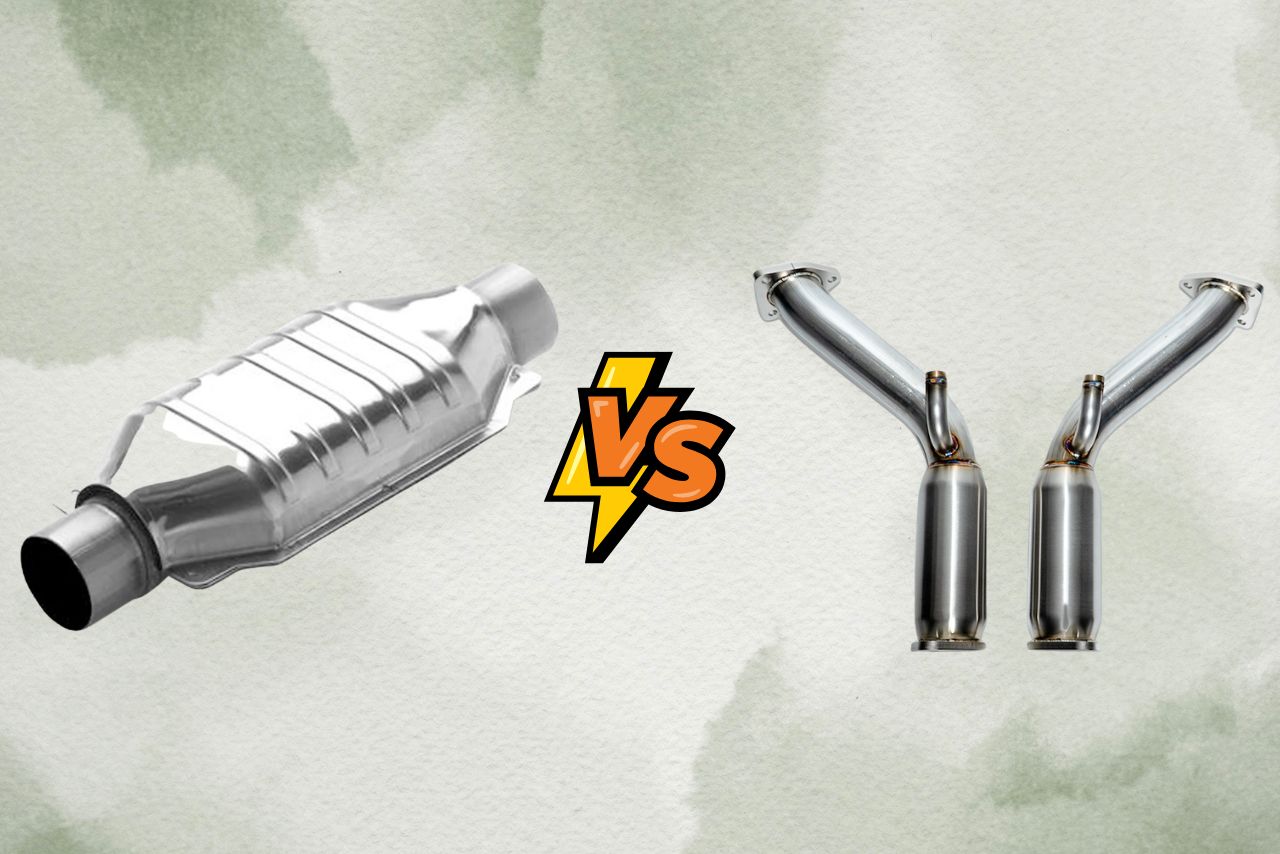When it comes to modifying a car’s exhaust system, two common options are high flow catalytic converters (or “cats”) and test pipes but which is best option? High Flow Cats vs Test Pipes Let’s find out.
Both options aim to increase the flow of exhaust gases, which can improve performance and sound.
However, there are some key differences between the two that car enthusiasts should consider before making a decision.
In this article, we’ll explore the pros and cons of high flow cats and test pipes, and help guide you towards the best choice for your vehicle.
High flow catalytic converters are better than OEM catalytic converters but not quite as good as test pipes. HFCs are better suited for California because of its strict emissions laws. Technically, high flow cats are still illegal since you are supposed to change your cats with anything other than an OEM cat unless your car is past a certain age.
Table of contents
Understanding High Flow Cats and Test Pipes:
If you’re looking to enhance the performance of your car’s exhaust system, two popular options to consider are high flow catalytic converters and test pipes.
Both pipes fundamentally serve the same purpose of increasing power output, but with some key differences.
What They Are?
To begin understanding the difference between high flow cats and test pipes, it’s important to first understand what they are.
High flow catalytic converters (also known as HFCs) have better flow than stock cats and offer a balance between performance gains and environmental friendliness.
Test pipes, on the other hand, completely remove the cat altogether for maximum performance gains at the cost of being environmentally unfriendly and illegal in many areas.
Factors Before Choosing:
Ultimately, choosing between high flow cats and test pipes comes down to your location (emissions regulations), personal preferences for sound/noise level, as well as cost considerations.
In addition, keep in mind that while removing a catalytic converter can result in more power gains due less restrictive airflow through a straight pipe design; however it also results in increased emissions – something that is not always ideal or legal.
As an experienced member or veteran driver running an aftermarket turbo or thinking about doing so with your engine exhaust system modifications.
Getting high quality headers along with proper piping is crucial for optimal results regardless if you plan on running resonated cat-pipes (with or without HFCs) or test pipes.
With either option there will be some loss of backpressure because these setups have fewer restrictions than OEM setups resulting in louder overall noise levels which can further be tuned depending upon individual likes such as adding mufflers/rings etcetera afterwards.
Overall though if you had to choose one type over another option I believe most professionals would recommend going with a high-flow catalytic converter instead.
Since this offers better performance gains compared to stock units yet still maintains legal status plus has no gas smell unlike those who go fully decatted/testpipe route even though that does provide more horsepower gained initially while costing less up front.
What are High Flow Cats?
If you’re considering upgrading your exhaust system, you may have come across the term “high flow cats”.
High flow catalytic converters are essentially a more efficient version of the stock cat on your car.
They contain a larger surface area for exhaust gases to pass through, which allows for better flow and improved performance.
The main benefits of high flow cats include:
- Improved exhaust flow
- Better engine sound compared to stock
- Legal compliance in states with vehicle emissions laws
While high flow cats aren’t as effective as test pipes when it comes to performance gains, they strike a balance between power and legality.
Additionally, they do not emit any unpleasant smells like test pipes can. If you want added horsepower without breaking the law or attracting unwanted attention from police officers, high flow cats may be the right choice for you.
What are Test Pipes?
Test pipes are an essential component of any high-performance exhaust system. These pipes are designed to replace the factory catalytic converter and are typically made of high-quality stainless steel.
The purpose of test pipes is to improve exhaust flow by reducing backpressure, which can significantly increase horsepower and torque.
Test pipes are also ideal for those who want to achieve a more aggressive exhaust note, as they provide a much louder and deeper sound compared to stock exhaust systems.
It’s important to note that test pipes are designed for off-road use only and are not street legal in most states. It’s crucial to check your local laws before installing test pipes onto your vehicle.
When installing test pipes, it’s recommended to have a professional mechanic perform the installation to ensure proper fitment and sealing.
Differences between High Flow Cats and Test Pipes:
| Feature | High Flow Cats | Test Pipes |
|---|---|---|
| Emissions | Reduce emissions | Do not reduce emissions |
| Sound | Quieter than test pipes | Louder than high flow cats |
| Power | May increase power slightly | May increase power more than high flow cats |
| Cost | More expensive than test pipes | Less expensive than high flow cats |
| Legality | May be legal in some states and countries | May be illegal in some states and countries |
High flow cats and test pipes are both popular options for car enthusiasts looking to improve their vehicle’s performance.
While they both serve a similar purpose of increasing exhaust flow, there are some key differences between the two.
In this listicle, we will explore the differences between high flow cats and test pipes.
1. Emissions Compliance:
High flow cats are designed to meet emissions standards and are legal in all 50 states.
Test pipes, on the other hand, are not emissions compliant and are only intended for off-road use.
2. Sound:
Test pipes tend to produce a louder and more aggressive exhaust note compared to high flow cats.
This is because test pipes eliminate the restrictive catalytic converter, allowing for more exhaust flow and a more pronounced exhaust sound.
3. Performance:
Both high flow cats and test pipes improve exhaust flow and can result in increased horsepower and torque.
However, test pipes typically provide more power gains due to their unrestricted design.
4. Price:
High flow cats are generally more expensive than test pipes due to their emissions compliance and the materials used in their construction.
Test pipes, on the other hand, are often cheaper as they are not emissions compliant and may use less expensive materials.
5. Maintenance:
High flow cats require regular maintenance to ensure they continue to function properly and meet emissions standards. Test pipes, on the other hand, require little to no maintenance.
6. Installation:

High flow cats typically require professional installation due to their emissions compliance and the complexity of their design.
Test pipes, on the other hand, can often be installed by the owner with basic hand tools.
7. Legal Issues:
Using test pipes on a vehicle that is driven on public roads can result in fines and legal issues.
High flow cats, on the other hand, are legal for use on public roads and will not result in any legal issues.
8. Environmental Impact:
High flow cats are designed to reduce harmful emissions and have a positive impact on the environment. Test pipes, on the other hand, eliminate the catalytic converter and can increase harmful emissions.
9. Warranty:
Using test pipes on a vehicle can void the manufacturer’s warranty. High flow cats, on the other hand, are designed to meet emissions standards and should not void the manufacturer’s warranty.
10. Resale Value:
Vehicles equipped with high flow cats typically have a higher resale value compared to those with test pipes.
This is because high flow cats are emissions compliant and legal for use on public roads, making them more desirable to
Pros and Cons of High Flow Cats and Test Pipes:
High flow cats and test pipes both have their pros and cons when it comes to upgrading your car’s exhaust system. Here are some of the advantages and disadvantages of each:
High Flow Cats:
- Advantages: They’re better than stock catalytic converters, legal in many locations, reduce emissions, produce less smell than test pipes, and provide a moderate performance gain.
- Disadvantages: They’re more expensive than test pipes, still not as good as completely removing the catalytic converter for maximum power gains.
Test Pipes:
- Advantages: Cheaper than high flow cats, offer the largest horsepower gain over any other exhaust upgrade option like headers or resonated cat pipes.
- Disadvantages: Test pipes are illegal in most locations where an emissions inspection is done due to its lack of any catalyst at all. The engine noise level will be much louder leaving you open to being pulled over and receiving unwanted tickets.
So while test pipes may seem enticing for gaining that extra bit of horsepower if you don’t need them to pass smog inspections then getting high flow cats is going to always be the best choice overall for balance between knowing you are contributing towards keeping our environment clean without sacrificing too much power output.
How High Flow Cats and Test Pipes Affect Performance?

High Flow Cats and Horsepower:
High flow catalytic converters can have a significant impact on the horsepower of your vehicle. The primary function of a catalytic converter is to reduce harmful emissions, but it can also restrict the flow of exhaust gases.
High flow cats are designed to address this issue by allowing for a greater volume of exhaust gases to pass through.
This increased flow results in less back pressure in the exhaust system, which can lead to improved horsepower and torque.
It’s important to note that the amount of horsepower gained from installing high flow cats can vary depending on the specific make and model of your vehicle, as well as other modifications that have been made to the engine.
It’s also important to ensure that the high flow cats you choose are compatible with your vehicle and meet local emissions regulations.
Test Pipes and Horsepower:
Test pipes eliminate the catalytic converter, which can increase the flow of exhaust gases and improve horsepower and torque. This increased flow can result in a significant power gain, making your car faster and more responsive.
However, it’s important to keep in mind that test pipes are not emissions compliant and may be illegal in many locations.
Also, the increased engine noise level may not be suitable for all drivers.
Overall, test pipes can provide a substantial horsepower boost, but it’s important to weigh the potential drawbacks before making a decision.
High Flow Cats and Sound:
High flow cats are designed to reduce emissions and produce less smell than test pipes. As a result, they typically have a milder exhaust note compared to test pipes.
While some drivers prefer the deeper and louder sound of test pipes, others may find it too aggressive or unpleasant.
It’s important to consider your personal preference and driving habits when choosing between high flow cats and test pipes.
Test Pipes and Sound:
Test pipes tend to produce a much louder and more aggressive exhaust note compared to high flow cats.
While some drivers may prefer this sound, others may find it too loud or obnoxious.
It’s important to keep in mind that the increased noise level may not be suitable for all driving situations, such as commuting in residential areas or driving long distances.
In addition, the increased engine noise can attract unwanted attention from law enforcement officers.
Which is Better for Your Car: High Flow Cats or Test Pipes?
When it comes to choosing between high flow cats and test pipes for your car’s exhaust system, there are a few factors you should consider to determine which is better suited for your needs.
If you’re concerned about emissions and live in a location with strict laws, then high flow cats may be the better option as they provide better emission control than test pipes.
Additionally, if you value legality and don’t want to risk getting pulled over or fined, then high flow cats would be the legal choice.
On the other hand, if you’re looking for more power gains and don’t mind sacrificing emissions control or legality concerns, then test pipes may be more suitable as they offer larger horsepower gains compared to high flow cats.
However, keep in mind that using test pipes will make your car louder and smell like gas due to the lack of catalytic converter.
It’s important to note that each car is different and what works best for one engine might not necessarily work well with another engine.
If you’re unsure which option is best for your specific car model and its modifications (such as headers), reach out to an experienced veteran forum member who drives a similarly modified vehicle or consult with a reputable aftermarket shop.
In any case, whether you choose high flow cats or test pipes depends on personal preference – prioritize either environmental concerns/legality or performance gains/loudness.
Just remember that making any changes to your exhaust system can affect how the engine rings throughout its lifespan.
High Flow Cats vs Test Pipes: Which is More Cost-Effective?
If you’re looking to upgrade your car’s exhaust system, you might be wondering whether to install high flow cats or test pipes.
High flow cats are a type of catalytic converter that allow for increased exhaust flow, while test pipes completely remove the catalytic converter.
While test pipes may be cheaper than high flow cats, they may not be the most cost-effective option in the long run.
- Firstly, test pipes can be illegal in some areas and may result in fines or penalties.
- Secondly, high flow cats can actually increase your car’s resale value, as they are a legal and environmentally-friendly option.
- Additionally, high flow cats can help improve your car’s performance by reducing back pressure and increasing horsepower.
Overall, while test pipes may be cheaper upfront, high flow cats are a more practical and cost-effective option for most car owners.
High Flow Cats vs Test Pipes: Which is More Environmentally-Friendly?
When it comes to the environmental impact of high flow cats versus test pipes, high flow cats are definitely the more environmentally-friendly option.
High flow catalytic converters have a honeycomb design with washcoat material that helps to reduce emissions by converting harmful pollutants into less harmful substances like carbon dioxide and water vapor.
On the other hand, test pipes completely eliminate the catalytic converter, resulting in much higher emissions of harmful pollutants such as nitrogen oxide and hydrocarbons.
This not only has negative effects on air quality, but also contributes to global warming and climate change.
So if you’re concerned about minimizing your car’s impact on the environment, choosing high flow cats over test pipes is definitely the way to go.
While they may be slightly more expensive than test pipes initially, they are worth it in terms of protecting our planet for future generations.
Remember that while aftermarket exhaust systems can improve performance and sound great, it’s important to consider their impact on both your car’s engine health and our world at large. So think twice before getting rid of your stock catalytic converter or opting for a setup that is too loud or smelly.
High Flow Cats vs Test Pipes: Which is More Legal?
High flow cats and test pipes are both aftermarket exhaust components that can enhance the performance of your vehicle. However, when it comes to legality, there is a significant difference between the two.
High flow cats are designed to replace the factory catalytic converters while still maintaining emissions compliance. This means that they have been certified by the Environmental Protection Agency (EPA) and are legal for use on public roads.
On the other hand, test pipes completely remove the catalytic converters from the exhaust system, which is illegal in most states.
The EPA has strict regulations on emissions, and removing the catalytic converters is considered tampering with the emission control system.
It is important to note that using test pipes on public roads can result in fines and even vehicle impoundment. Therefore, if you want to stay within the bounds of the law, high flow cats are the way to go.
Conclusion and final thoughts 💭
While high flow cats and test pipes both offer benefits in terms of performance and sound, there are important factors to consider when deciding which option is best for your vehicle.
If you prioritize environmental concerns and legality, high flow cats are the clear winner.
They may be slightly more expensive upfront, but they offer long-term cost savings by increasing resale value and reducing emissions.
On the other hand, if you prioritize performance gains and loudness over environmental concerns and legality, test pipes may be a viable option – just make sure you’re aware of the potential legal consequences.
Ultimately, whichever option you choose, make sure to consult with experts who can help you make an informed decision that fits your specific vehicle and driving needs.
Latest Posts:
- Can WD-40 Remove Scratches on Cars? (Hint: Yes, but…)
- Can You Use a Drill to Polish Your Car? (We Tried it Out!)
- Should You Cover Car Scratches With Stickers? (REVEALED!)
- Buick Service Stabilitrak: (Causes & 100% Guaranteed Fix!)
- Common Holden Trax Problems (Causes & 100% Proven Fixes!)
- Jeep Commander Transmission Over Temp: (Guaranteed Fix!)











Leave a Reply